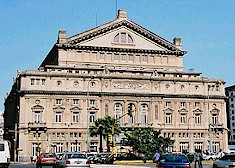|
Downtown:
History / Historia |
|
Porteños
are particularly fond of this area.
It reflects a large part of the Argentine past which becomes
evident everywhere. Plaza de Mayo, center around which the city was built, has
plenty of palm trees and monuments.
Since its foundation in 1536
as a stronghold, the most decisive historical events took place
there.
It couldn't have been otherwise since it is surrounded by the Pink House (site of the National Government), the
Metropolitan Cathedral and the Cabildo. |
|
At
the end of Avenue de Mayo you can find the Two Congresses Square.
You will be surprised by the beautiful fountain ornamented with
horses and angels.
The Avenue 9 de Julio is definitely the widest avenue in the
world (140m width). It is magnificent with its huge
advertisements and buildings, palo borracho trees
and the Obelisk (picture on the right), a symbol for the porteños.
On this avenue you can also find one of the most important
theaters of lyrical music of the world: the Colon Opera House.
You can picture the hasty rhythm of porteños if you walk along
Florida street, full of stores.
At night there are plenty of theaters and cinemas in Corrientes
Avenue, for that reason known as "the street that never
sleeps". |

|
 |
Esta
zona es particularmente apreciada por los porteños ya que encierra
buena parte del pasado argentino, latente en cada uno de sus
rincones.
La Plaza de Mayo, que dio origen a la ciudad, hoy se puebla de
palmeras y monumentos. Desde su fundación en 1536, como plaza
del fuerte, los hechos históricos más decisivos se produjeron
allí. No podía haber sido de otro modo, pues en su entorno se
ubican la Casa Rosada (Sede del Gobierno Nacional), la Catedral
Metropolitana y el Cabildo. |
Al final de la Avenida de Mayo apreciarás la Plaza de los Dos
Congresos. Te sorprenderá gratamente la hermosa fuente decorada con
caballos y querubines. Definitivamente la Avenida 9 de Julio es
la avenida más ancha del mundo (de una vereda a otra alcanza
los 140m). Todo en ella es magnífico: enormes carteles, edificios,
una población de palos borrachos y el Obelisco (foto de la
derecha),
inconfundible símbolo porteño. En esta avenida encontrarás
también el Teatro Colón),
uno de los más importantes de la lírica mundial.
Podrás observar el ajetreado ritmo porteño recorriendo la
calle Florida, repleta de negocios. Por la noche, teatros y
cines se dan cita en la Avenida Corrientes conocida como "la calle que
nunca duerme". |
|
Source: Buenos Aires Guest Guide
(Jones Editores)
Photos: Mariano G. Jiménez
|
|